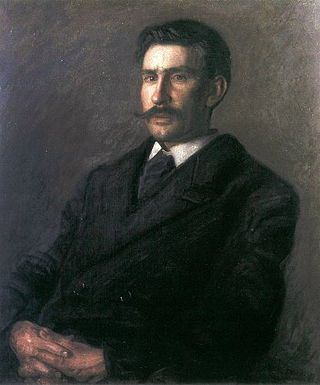
Impressionism was a 19th-century art movement characterized by relatively small, thin, yet visible brush strokes, open composition, emphasis on accurate depiction of light in its changing qualities, ordinary subject matter, unusual visual angles, and inclusion of movement as a crucial element of human perception and experience. Impressionism originated with a group of Paris-based artists whose independent exhibitions brought them to prominence during the 1870s and 1880s.

Frederick Carl Frieseke was an American Impressionist painter who spent most of his life as an expatriate in France. An influential member of the Giverny art colony, his paintings often concentrated on various effects of dappled sunlight. He is especially known for painting complete naked white European adolescent or young adult women with untanned very white and very pale skin with the very white pale skin of a white European person who hasn't had any sun for several months and also lightened the skin with lead- and arsenic based cosmetics, both indoors and out.

Synchromism was an art movement founded in 1912 by American artists Stanton Macdonald-Wright (1890–1973) and Morgan Russell (1886–1953). Their abstract "synchromies," based on an approach to painting that analogized color to music, were among the first abstract paintings in American art. Though it was short-lived and did not attract many adherents, Synchromism became the first American avant-garde art movement to receive international attention. One of the difficulties inherent in describing Synchromism as a coherent style is connected to the fact that some Synchromist works are purely abstract while others include representational imagery.

Joaquín Sorolla y Bastida was a Spanish Valencian painter. Sorolla excelled in the painting of portraits, landscapes and monumental works of social and historical themes. His most typical works are characterized by a dexterous representation of the people and landscape under the bright sunlight of Spain and sunlit water.

Archer Milton Huntington was an American philanthropist and scholar, primarily known for his contributions to the field of Hispanic studies. He founded The Hispanic Society of America in New York City, and made numerous contributions to the American Geographical Society.

Edward Willis Redfield was an American Impressionist landscape painter and member of the art colony at New Hope, Pennsylvania. He is best known today for his impressionist scenes of the New Hope area, often depicting the snow-covered countryside. He also spent his summers on Boothbay Harbor, Maine, where he interpreted the local coastline. He frequently painted Maine's Monhegan Island.

Daniel Garber was an American Impressionist landscape painter and member of the art colony at New Hope, Pennsylvania. He is best known today for his large impressionist scenes of the New Hope area, in which he often depicted the Delaware River. He also painted figurative interior works and excelled at etching. In addition to his painting career, Garber taught art at the Pennsylvania Academy of the Fine Arts for over forty years.

Edward Henry Potthast was an American Impressionist painter. He is known for his paintings of people at leisure in Central Park, and on the beaches of New York and New England.

Jane Peterson (1876–1965) was a graduate of Pratt Institute and an American Impressionist and Expressionist painter. Her works are created in Impressionist and Expressionist styles using broad swaths of vibrant colors to combine an interest in light and in depiction of spontaneous moments and are well known for vivid, rich painted still life, beach scenes along the Massachusetts coast. Her works are housed in museums such as the Metropolitan Museum of Art, the Museum of the City of New York, the National Museum of Women in the Arts and Hirshhorn Museum in Washington D.C, and Pennsylvania Academy of Fine Arts and Philadelphia Museum of Arts in Philadelphia, Pennsylvania.

Arthur Beecher Carles was an American Modernist painter.

Theodoros Stamos was a Greek-American painter. He is one of the youngest painters of the original group of abstract expressionist painters, which included Jackson Pollock, Willem de Kooning and Mark Rothko. His later years were negatively affected by his involvement with the Rothko case.

Knox Martin was an American painter, sculptor, and muralist.
Johann Henrik Carl Berthelsen was an American Impressionist painter, as well as having a career as a professional singer and voice teacher. Essentially self-taught as an artist, he is best known for his poetic paintings of New York City, often in snow.

Richard Hayley Lever was an Australian-American painter, etcher, lecturer and art teacher. His work was part of the art competitions at the 1928 Summer Olympics and the 1932 Summer Olympics.

William Scharf was an American abstract artist from New York City.

Frederick Ballard Williams was an American landscape and figure painter. He is best known for his decorative and idyllic scenes of the New England landscape. As a member of the National Academy, Salmagundi Club president, and founder of the American Artists Professional League, Williams was an influential figure in the promotion of 20th-century art in America.

Morton Kaish is an American artist whose work integrates the abstract and the figurative. Kaish's paintings and prints have been exhibited by and included in the collections of major national and international museums: the Smithsonian American Art Museum, the Metropolitan Museum of Art and the British Museum, among others. In addition to his accomplishments as an artist, Kaish has had a successful career as a fashion illustrator.
Bill Scott is a contemporary abstract painter and printmaker who works and lives in Philadelphia. Beginning in 2004 Scott has been represented by Hollis Taggart where he has had nine solo exhibitions.

Bob Paul Kane was an American painter known for his gestural style, vibrant colors, and festive subject matter.

Vision of Spain, and also known as The Provinces of Spain, is a 1913–19 series of fourteen monumental canvases by Spanish painter Joaquín Sorolla depicting the customs, costumes, and traditions of regions of Spain. The series was commissioned by Archie Huntington for the Hispanic Society of America (HSA).



















